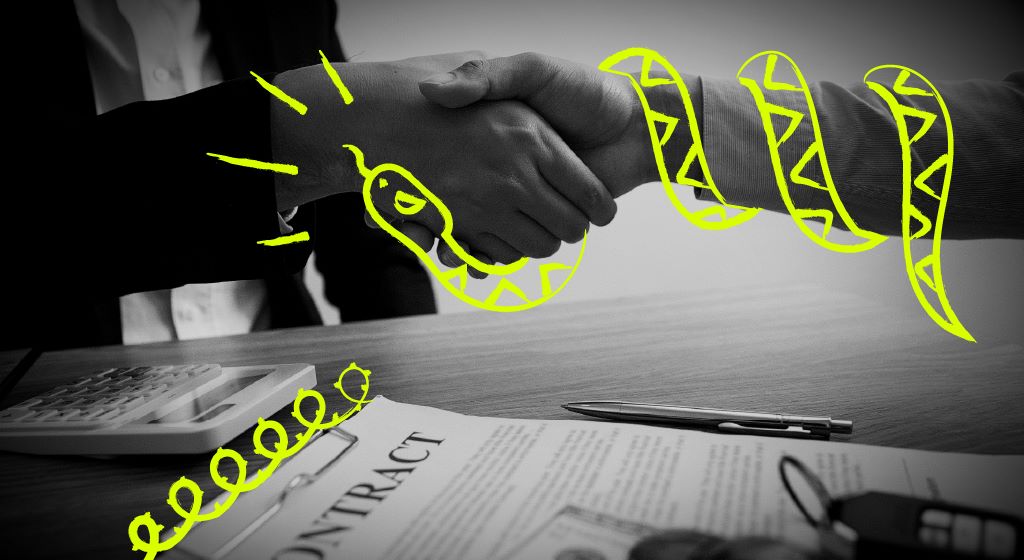Breakups happen
They just do, there’s no way around it. You didn’t think that once you find a client they stay with you forever, did you? Even the most loyal customers may part ways with your digital agency, for a number of reasons. And when the biggest ones leave, it can sometimes look like the end of the world, raising a question, “How to cope with losing a client?”

It is not necessarily your fault when it happens. Clients come and go. BBDO lost one of its biggest clients, Visa (and won it back in 2010, but that’s a different story). The Martin Agency lost Walmart to Publicis Groupe. These agencies have a well-earned reputation and high credibility – and still, some of their clients decide to part ways with them. So, if it happens to you, it does not mean that you did something wrong. Your customers may have had their own reasons.
Or, it could be your fault as well. Digital agencies do make mistakes that cost clients. Below, we’ll analyze the most likely causes from client-side and agency-side perspectives, and figure out what losing a client costs. We’ll also think of what to do when you lose a major client.
Are there any tell-tale signs?
Clients rarely fall off your agency unexpectedly. Often, there are red flags indicating that something went wrong in your relationship. Reilly Newman (Founder and Lead Strategist at Motif Brands) believes that the brightest indicator of the status of any type of relationship is the quality of communication.
“When a client starts to communicate less often or more briefly, typically something will be “off,” and it is best to jump on it right away and see if there has been any confusion or miscommunication. From there, do an audit of the relationship, makeup, and honor the relationship (if it has been healthy) and exceed their expectations,” says Newman.

Reilly Newman, founder, and Lead Strategist at Motif Brands
Experts agree upon the following signs indicating your client is about to leave:
- They start micro-managing everything;
- They inform your agency of important changes late, if ever at all;
- They change the contact person;
- They start to ask for discounts or purchase less, they request one revision after another;
- They are late with the payments.
Why do clients leave?
Sometimes, losing a big client becomes inevitable despite all the effort your team puts in for your customers. Before indulging in constructive self-analysis (or completely excruciating self-loathing), we recommend that you consider the following:
Client’s perspective
Their budget has decreased
The situation you probably have little to no way to influence. Be it because of inefficient management or unpredicted emergencies, the client has to cut their investments into outer services (yours included) to focus their budget on internal needs.
They’ve found better services elsewhere
You can see it as your fault (like in, “We failed to become the best possible solution for our client”). However, competition is harsh. There is always a chance that another agency offers the same services as you, but for a better price. Or with a more appealing attitude. Or promotes itself better. Or is in no way better than you, but the client just feels they want a change.
Changes in management
Your client’s former project manager saw a lot of value in your relationships, but the new one doesn’t. They want to prove themselves useful, so they start changing everything their hands can reach. Or, a decision-maker on your client’s side decides to prioritize other directions.
Internalizing
Your client might have hired an in-house employee to cover the tasks you previously paid for. Simple as that.
Could it be your mistake?
The real question you need to ask yourself when you lose a client is, “What did I do to cause their leave?” Some circumstances are out of your control. But, if you dig deeper, you will probably find one or several flaws and mistakes in your approach.
Unclarified expectations
You’re running a small agency of 10 to 15 enthusiasts ready to work day and night. One day, a famous brand contacts you and makes an order. They pay well, but they expect you to do everything in 24 hours. You know you lack manpower. You know you don’t have the resources. But, afraid to lose a client like that, you agree to their terms without discussion. And, most likely, you fail to deliver a satisfying result.
“A digital agency that neglects to establish expectations before the relationship even starts is likely to fall short. This then will create areas of miscommunication which will eventually erode the overall results and relationship,” says Newman.
Another way around it? Clarify your customer’s expectations:
- Talk about deadlines;
- Discuss the number of free revisions your agency can provide;
- Point out what you can and cannot do within the set time limit.
If a customer leaves after the discussion stage, they may still return later with a smaller request matching your agency’s capacities. If you fail a customer after agreeing to their terms, you will lose them forever.
Flawed communication
The lack of communication
This is a mistake many agencies tend to make. You clarify your customer’s needs. You discuss the terms. You start working – and go off of the radar for the entire project duration.
In this case, your client is left dangling in uncertainty. Should they guide your creative process? Will there be additional briefing sessions on each project stage? What’s your progress? Are you even working on their order?
No clear point of contact
If your client has to discuss project details with a multitude of people, it can lead to conflicting communication and misunderstandings. For you, it means two things: revisions and the loss of a client.
Overcomplication
Sometimes, agencies convey so much professional slang when discussing technical details with the clients that it starts looking completely cryptic to them. Whether it is done unintentionally or to disclaim responsibility and cover up mistakes, complicated tech talk will intimidate your clients to the extent that they decide to find another agency.
You failed
Not every failure causes clients to leave. After all, if there was no place for tolerance and second chances in business, young companies and startups would disappear immediately after entering the market.
However, a failure that you conceal and refuse to openly admit is what signals your customer to abandon the ship.
A wrong approach to customer relations
If you want your clients to stick around, you should constantly seek to add value to your relationship. Instead, some agencies attempt to hold their clients by force. If you:
- demand clients to sign long-term contracts with exclusive privileges;
- push them by imposing services they never asked for;
- fail to communicate what you are going through and why.
and pressure them by using “or else” rhetoric, your customers will eventually turn away from you.
Laugh all you want, sometimes agencies do that.
What happens now?
Losing big client stories can get terrifying. From a startup shutdown to wading through chaos and turmoil on the unexpectedly collapsed partnership, client loss can look (and be) devastating.
However, even in such cases, your startup survival is plausible. Of course, you must know what’s coming your way and create a backup plan. Let’s figure out what awaits you and what you can do about it.
Loss of revenues
As your major client vanishes on the horizon, so does the solid share of your revenues. This means halted growth plans, fewer benefits/bonuses for your employees, and increased expenses on customer acquisition.
Confusion among employees
This is not bound to happen. But if you are a small company and your team knew who was your biggest sacred cow, bad news can cause people to start worrying about losing their jobs.
Getting emotional
Of course, you know that every business loses big clients at least once. But, the truth is that loss hits us harder than gain. Even if you win a much bigger client the next day, you will still feel bad. Because of this, you can miss an opportunity to make up for the loss. It is important to carefully manage your emotions and stay open to new possibilities.
Reputation losses
If you lose a customer because you failed them or because of miscommunication, they are likely to spread the word. Word of mouth is mighty in the epoch of social media. Sad but true: 95% of unsatisfied customers share their negative opinions with others. 45% do it on social media, where 63% of consumers read their reviews and draw conclusions. You don’t want that.

What would the worst-case scenario look like?
If you developed your agency with an eye on the needs of your biggest client, you are screwed. Here is how Reilly Newman puts it:
“Worst case scenario would look like layoffs and financial loss due to agencies hiring based on that client’s specific needs. Once that is gone, and if an agency does not recover by filling the now open canyon, jobs will be lost along with revenue, profit, and overall growth. You may even slide backward compared to the previous years. Ouch.”
Newman’s scenario sums up all the bad things that can happen to your agency. Indeed, ouch.
To avoid this, Newman advises never to have clients be more than 20% of your revenue (according to David Baker, if a client makes 25% or above of your annual revenue, they are LARGE, and their loss can be detrimental to your business).
Your plan of action
Rounding up the relationship with the client properly
It is important to know how to be professional about losing a client. Firstly, because their leave might be temporary and they could be planning to return in the future. Secondly, because the world is a small place, and the word spreads quickly. You don’t want to be (or even seem) rude.
According to Reilly Newman, here is one way to manage things when your best customer abandons ship:
“Whenever in business, I believe one should always be polite and take the high road (even if the other party is being distasteful). If someone doesn’t want your services, thank them for their time and wish them well. Never act desperate for work. Then in your calendar, mark a day that is 30-90 days (depending on the prospect) out and check in with them. Not to be annoying and attempt to sell them again, but simply to see how they are doing. Then see what happens.”
The “goodbye” phone call is extremely important. This client was your reliable source of income for a time being – at least, be thankful for that and express your gratitude. Besides, this is a good chance to ask for feedback and to possibly figure out who they are now doing business with and why.
Your survival strategies
After calling the customer and confirming that they are leaving, you need to take action. Knowing how to create a transition plan when losing a client can spare you a lot of trouble. Here are some ideas for you.
Drink and mourn
Just kidding. But hey, you need some time to realize that your biggest client’s gone. Nothing good will come out of acting in panic.
Tell your team
They will start to suspect, eventually. Better you tell them the bitter truth than they learn it themselves. Besides, secrecy is not a good corporate policy. Then, observe their reactions. Some of the possible ones can look like this:
- They are worried (which is normal);
- They are ready to roll up their sleeves and work hard to save the day (which is good news for you);
- They don’t care much (which should make you ask yourself why you keep employing them).
Discuss the problem with everyone involved
It is crucial that you understand your mistakes. The point here is not to find a whipping boy but to recreate the work process with the client and understand what went wrong and when. If you made that final phone call to the customer, analyze their feedback and match it with your conclusions.
Count your losses and cut expenses
You want to know how much time you can stay afloat. Map your sales cycle to see (realistically) how many sales you can close in the nearest future, who is going to commission you for your services, and when. Review all of your business expenses, and eliminate those that aren’t crucial for your survival and for your ability to do your job.
Get in touch with your other customers
If you’re making the same mistakes with them, you want to know about it ASAP. Ask them for feedback, offer your help with the challenges they are currently facing. If your other clients are already aware of your situation, admit and clarify it. You don’t want to look like you’re hiding an elephant in a closet.
Focus on your existing clientele
Newman suggests aiming to recover the full amount (or portion) of the lost incomes by a certain date through new work or approaching existing clientele to sell them on additional services. You should not be pushy, though: you don’t want to look desperate in their eyes, especially if they already know about your situation.
Offer value
Loyal customers may forgive your mistakes and flaws. By the end of the day, all the differences in the world can be made by:
- Your attitude;
- Customer service;
- Your ability to keep promises;
- Regular communication with your audience;
- Transparency.
Work with freelancers
Partially, at least. When a big customer abandons your agency, you often lose a bunch of tasks and requests specific to them. If you hired in-house specialists to work on these tasks, you might have had to hire some (or even all) of them. Sounds awful, right?
Well, you don’t have to put all your eggs in one basket. If things go south with your next big customer, having freelancers on your team will alleviate the pain greatly. You won’t have to fire employees. Your financial losses will be smaller. You will be able to hire the same people for the next project.
Hire freelancers from Lemon.io – we have some of the best contractors on the market for web and software development.
How to get a business client back
Miracles do happen, and even if your best client is gone, it does not mean you cannot win them back. UPS (United Parcel Service) faced a disastrous strike and lost thousands of workers back in 1997, along with its clients. The company was on the brink of extinction.
Guess what? In 1998, UPS increased its profits by 87%. All due to its persistent comeback strategy that they started implementing immediately after the strike was settled. They called their clients, offered them discounts, and met them in person. They apologized and reassured everyone that things were great again. They provided perfect customer service and demonstrated a cheerful and confident attitude.
It worked.
Should you rush to win back the customer?
No rush. Your customer had reasons to leave, and by trying to handcuff them you will only make things worse. Be patient. A customer might want to return later, especially if your cooperation was fruitful to them.
“Depending on your positioning and the nature of the relationship, there may be an opportunity to assist in other ways such as transitioning or reducing the scope of work to something that makes sense for them. All in all, be respectful to them and their internal decision. Never be pushy or rude,” says Reilly Newman.
Explore other possibilities to stay within the client’s field of view than trying to return your collaboration back in full.
Steps to win your best client back
Learn why they stopped buying from you
Perhaps, they already told you during that goodbye phone call, remember?
Stay in touch
Don’t write off someone simply because they are not your customer anymore. Make a short call every now and then, and drop a polite email asking how things are going with them. Once you sever the connection, you disappear to them forever. “Out of sight, out of mind,” as the saying goes.
Research their current business situation
When you lose a client, the breakup might be the result of a changed business model. To make them an offer they can’t refuse, you must know what they need right now. To some extent, approach a lost customer as a completely new one.
Make them an adjusted offer
Wait it out. Take your time to create a special offer that would meet the current needs of your former client. During the period of your cooperation, they got to know what to expect from you. This new offer might surprise them, and make them consider giving you a second chance.
Don’t strive to make it a “bigger, better version of the same as before.” Focus on offering a unique service or package that precisely meets the challenges they are facing. Then write your ultimate “Win Back Client Letter” with the proposal, and send it.
Learn to move on
Sometimes, things don’t work out. In this case, just move on and ensure you don’t repeat the same mistakes with the new customers.









